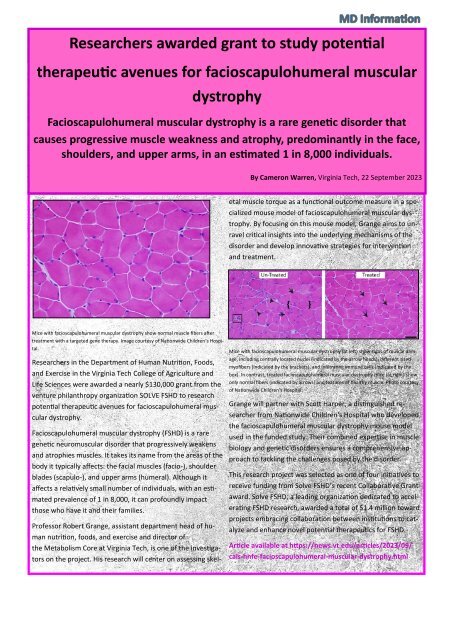MDF Magazine Issue 72 December 2023
You also want an ePaper? Increase the reach of your titles
YUMPU automatically turns print PDFs into web optimized ePapers that Google loves.
Researchers awarded grant to study potential<br />
therapeutic avenues for facioscapulohumeral muscular<br />
dystrophy<br />
Facioscapulohumeral muscular dystrophy is a rare genetic disorder that<br />
causes progressive muscle weakness and atrophy, predominantly in the face,<br />
shoulders, and upper arms, in an estimated 1 in 8,000 individuals.<br />
By Cameron Warren, Virginia Tech, 22 September <strong>2023</strong><br />
tors on the project. His research will center on assessing skeletal<br />
muscle torque as a functional outcome measure in a specialized<br />
mouse model of facioscapulohumeral muscular dystrophy.<br />
By focusing on this mouse model, Grange aims to unravel<br />
critical insights into the underlying mechanisms of the<br />
disorder and develop innovative strategies for intervention<br />
and treatment.<br />
Mice with facioscapulohumeral muscular dystrophy show normal muscle fibers after<br />
treatment with a targeted gene therapy. Image courtesy of Nationwide Children’s Hospital.<br />
Researchers in the Department of Human Nutrition, Foods,<br />
and Exercise in the Virginia Tech College of Agriculture and<br />
Life Sciences were awarded a nearly $130,000 grant from the<br />
venture philanthropy organization SOLVE FSHD to research<br />
potential therapeutic avenues for facioscapulohumeral muscular<br />
dystrophy.<br />
Facioscapulohumeral muscular dystrophy (FSHD) is a rare<br />
genetic neuromuscular disorder that progressively weakens<br />
and atrophies muscles. It takes its name from the areas of the<br />
body it typically affects: the facial muscles (facio-), shoulder<br />
blades (scapulo-), and upper arms (humeral). Although it<br />
affects a relatively small number of individuals, with an estimated<br />
prevalence of 1 in 8,000, it can profoundly impact<br />
those who have it and their families.<br />
Professor Robert Grange, assistant department head of human<br />
nutrition, foods, and exercise and director of<br />
the Metabolism Core at Virginia Tech, is one of the investiga-<br />
Mice with facioscapulohumeral muscular dystrophy (at left) show signs of muscle damage,<br />
including centrally located nuclei (indicated by the arrow heads), different sized<br />
myofibers (indicated by the brackets), and infiltrating immune cells (indicated by the<br />
box). In contrast, treated facioscapulohumeral muscular dystrophy mice (at right) show<br />
only normal fibers (indicated by arrows) and features of healthy muscle. Photo courtesy<br />
of Nationwide Children’s Hospital.<br />
Grange will partner with Scott Harper, a distinguished researcher<br />
from Nationwide Children's Hospital who developed<br />
the facioscapulohumeral muscular dystrophy mouse model<br />
used in the funded study. Their combined expertise in muscle<br />
biology and genetic disorders ensures a comprehensive approach<br />
to tackling the challenges posed by the disorder.<br />
This research project was selected as one of four initiatives to<br />
receive funding from Solve FSHD’s recent Collaborative Grant<br />
award. Solve FSHD, a leading organization dedicated to accelerating<br />
FSHD research, awarded a total of $1.4 million toward<br />
projects embracing collaboration between institutions to catalyze<br />
and enhance novel potential therapeutics for FSHD.<br />
Article available at https://news.vt.edu/articles/<strong>2023</strong>/09/<br />
cals-hnfe-facioscapulohumeral-muscular-dystrophy.html

















